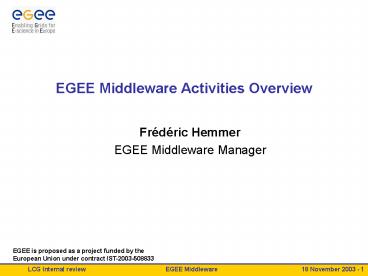EGEE Middleware Activities Overview - PowerPoint PPT Presentation
1 / 11
Title:
EGEE Middleware Activities Overview
Description:
Information Collection and Accounting (UK) Resource Brokering (Italy) Data Management (CERN) ... Ensure Software clusters follow Architecture & Design rules ... – PowerPoint PPT presentation
Number of Views:65
Avg rating:3.0/5.0
Title: EGEE Middleware Activities Overview
1
EGEE Middleware Activities Overview
- Frédéric Hemmer
- EGEE Middleware Manager
EGEE is proposed as a project funded by
the European Union under contract IST-2003-508833
2
Middleware Re-engineeringGoals and Objectives
- Provide robust, supportable middleware components
- Select, re-engineer, integrate identified Grid
Services - Evolve towards Services Oriented Architecture
- Adopt emerging OGSI standards
- Multiple platforms
- Selection of Middleware based on requirements of
- The applications (Bio HEP)
- In particular requirements are expected from
LCGs ARDA HepCAL - The Operations (i.e. LCG)
- E.g. deployment, updates, packaging, etc..
- Support and evolve of the middleware components
- Evolve towards OGSI
- Define a re-engineering process
- Address multiplatform, multiple implementations
and interoperability issues - Define defect handling processes and
responsibilities
3
EGEE Middleware Activity
- Activity concentrated in few major centers
- Key services
- Information Collection and Accounting (UK)
- Resource Brokering (Italy)
- Data Management (CERN)
- Quality Assurance (France)
- Security (Northern Europe)
- Middleware Integration (CERN)
- Middleware Testing (CERN)
4
Overall Approach
- Support the components from PM 0
- Start with LCG-2 code base as used in April04
- Evolve towards OGSI
- Allow for component per component deployment
- Aim at continuous Integration and Testing
- Avoid big-bang releases
- Allow for selected components to be deployed and
used - Leverage on SPI Tools
- Common Tools with LCG
- Nightly Builds
- Nightly Tests
- The two major software release deliverables are
snapshots - Defined base for reviews
- Quality Assurance
- Use QA processes and methods as defined by the
Quality Assurance Joint Research Activity
5
Some issues to be addressed
- Reliability and resilience
- Allow for failure free operations for long
periods - Avoiding manual interventions
- Robustness
- Be able to handle abnormal situations
- Ensure some level of fault tolerance
- Security
- Restricted access to resources including data
- Comply to security infrastructure
- Scalability
- Scale up to requirements defined by Operations
(i.e. LCG) - Maintainability, usability, supportability
- Configuration Management
- Documentation, packaging, defect handling
processes,. - Standardization and service orientation
- Comply to OGSA/OGSI
- Ensure interoperability with other
implementations
6
Milestones
7
Deliverables
PM9 12-2004 First EU Review
PM18 09-2005 Second EU Review
8
EGEE Middleware Management Structure
9
Overall EGEE Project Management
10
Partners efforts requested
11
Summary
- The EGEE middleware activity will provide a
middleware package - satisfying requirements agreed with LCG (HEPCAL,
ARDA, etc.) - and equivalent requirements from other sciences
- Very tight timescales
- Hiring should happen soon to ensure project fully
staffed from start-up in April 2004 - Essential to have processes in place before
project start up - Essential to ensure close LCG-EGEE collaboration
- Management structure have been adapted
- LCG-2 as a base for EGEE Middleware as of April
2004
12
Architecture Team
- Defines architecture and planning
- A draft of System Requirements, Architecture,
short list of middleware components should be
available shortly after project start - Takes input from Applications and Operations
- Define the list of components to be re-engineered
- Documents established agreements with providers
- Each software cluster has an architect
13
Engineering Management Team
- Middleware Engineering Process Management
- Ensure Software clusters follow Architecture
Design rules - Ensure adherence to Software Engineering Process
- Composed of
- Middleware Manager
- Chief Architect
- Implementation group Manager
- Implementation clusters Managers
- Integration Testing Manager
- Quality Documentation person
14
Quality Assurance































